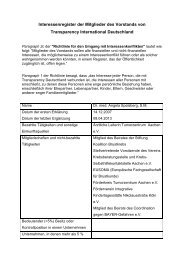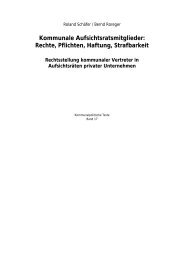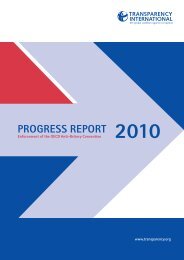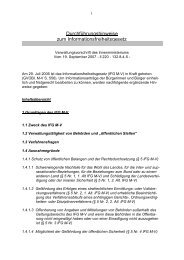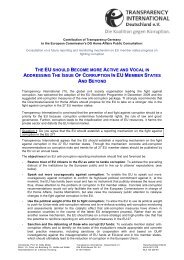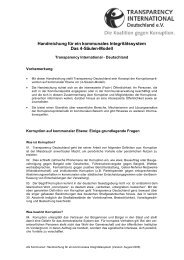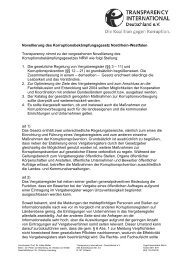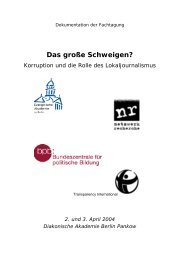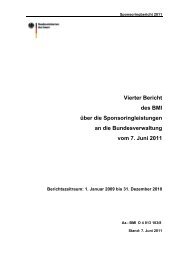The Anti-Corruption Plain Language Guide - Transparency ...
The Anti-Corruption Plain Language Guide - Transparency ...
The Anti-Corruption Plain Language Guide - Transparency ...
You also want an ePaper? Increase the reach of your titles
YUMPU automatically turns print PDFs into web optimized ePapers that Google loves.
Foreword:<br />
While the world is not free from corruption, it is a very different place than when <strong>Transparency</strong> International began<br />
its work more than 15 years ago. <strong>The</strong>re has been a marked increase in the understanding of corruption’s ills and<br />
the need to prevent, mitigate and combat it. Yet the financial and economic crisis in 2008 has served as a reminder<br />
of what can happen when transparency, accountability and anti-corruption become afterthoughts rather than the<br />
guide for one’s actions.<br />
Having a common understanding and language for the anti-corruption movement is one channel for ensuring that<br />
such breakdowns and abuses are prevented in the future. It is in this spirit that this plain language guide has been<br />
developed to capture the key terms and their meanings for TI and to provide the anti-corruption movement with a<br />
resource to work more effectively with government, private sector and civil society stakeholders.<br />
Introduction:<br />
<strong>Corruption</strong> and its effects are a global dilemma. From small bribes paid to police officers in Bangladesh to the holding<br />
of stolen assets by banks, the impacts from these abuses on states and citizens are the same: the undermining<br />
of the rule of law, the violation of rights, opaque institutions, lost public resources and weakened national integrity.<br />
To effectively address these problems, anti-corruption solutions need to be pursued through coordinated and deliberate<br />
action by international, national and local partners that use the same language and agree on its meaning.<br />
In response, TI has developed the first “<strong>Anti</strong>-<strong>Corruption</strong> <strong>Plain</strong> <strong>Language</strong> <strong>Guide</strong>”. <strong>The</strong> <strong>Plain</strong> <strong>Language</strong> <strong>Guide</strong> offers a<br />
set of standardised, easy-to-understand definitions, providing readers with concrete examples in practice of how TI<br />
approaches these issues. Relevant links are also provided for further background information or research.<br />
<strong>The</strong> aim of the guide is to provide clarity on the terms that the anti-corruption movement uses most in its daily work<br />
as well as those associated with new and emerging issues. <strong>The</strong> terms in this guide have been selected given their<br />
wide use in diverse forums and across the public and private sectors. Each term is intended to stimulate a dialogue<br />
— within academia, by the business community, among governments and parliamentarians, by NGOs and the media,<br />
and in international development circles — on how to address corruption.<br />
<strong>The</strong> experiences of TI chapters in over 90 countries have formed the basis for this guide, the terms selected and<br />
the definitions used. <strong>The</strong> guide is the result of the collaborative efforts of a number of <strong>Transparency</strong> International<br />
chapters across different regions. It reflects the extensive consultations that they held with local stakeholders to<br />
devise a short list of terms and definitions that can be understood across different cultures, languages and contexts.<br />
Many of these terms are in continual evolution as the anti-corruption movement works to better understand what<br />
is ‘governance’, ‘civil society’ or even ‘corruption’.<br />
<strong>The</strong> guide serves as a platform for continuing this discussion as the movement evolves, grows and continues to learn.<br />
It is a living document that will be debated, expanded and updated.<br />
We look forward to your continued help in this process.



